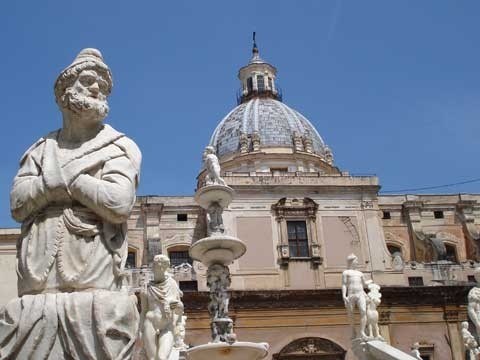In Sicily, I wondered if I wasn't the unwitting victim of some cosmic brand of "omerta" - Mafia lingo for an act of non-co-operation.
Nothing big. I didn't encounter a crime boss and no one asked me to accept a bribe. It was just that bad timing, poor directions, overwhelmed public transit and maybe a little silent non-co-operation, plagued my friend and me during a two-week visit. Worst of all, I couldn't seem to get into the one sight I would not miss - the Cappella Palatina (Palatine Chapel) in the Palazzo Normanni in the city of Palermo.
Sicily's 3,000-year history reads like one long series of nightmares. Yet, a rare beam of light turns out to be the Norman king Roger II - widely viewed as one of Europe's most gifted and charismatic rulers.
OK, so Roger died in 1154, succeeded by his son "William the Bad." But he drew up Sicily's first code of law, welcomed the learned and the foreign, patronized the fine arts, and went on to rule long and successfully over all of southern Italy.
And with the help of friends like the great Islamic map-maker al-Idrisi, who lived at his court in Palermo, Roger left behind a private chapel entirely covered in Byzantine mosaics, said to be a perfect blend of Christian and Arabic art.
This Cappella Palatina, while perhaps, at one time, no finer than the more famous Hagia Sofia basilica-turned-mosque-turned-museum in Istanbul, is infinitely better preserved. In fact, it's in pristine shape. Some scholars claim that it rivals the great Byzantine mosaics in Ravenna, Italy. But getting into this chapel wasn't going to be easy. Indeed, from my arrival in Palermo, it took on the feel of a Grail-like quest.
Our Alitalia flight from London hit the Palermo runway with a thud and then screeched to a halt. We'd booked a budget hotel online and while the Casena dei Colli turned out to be a delightful garden retreat, it was two public bus rides from the city centre (one of which ceased operating mid-evening, leaving us stranded at a distant roundabout).
Weeks of uncollected garbage bags lay heaped in the lane behind the hotel. At the bus stop, a nice looking businessman I fell into chatting with said of his native town: "Unfortunately, Palermo is a very unlucky city." He didn't elaborate. (According to my 2008 edition of The Rough Guide to Sicily, 80 per cent of stores in the island's largest cities of Palermo and Catania currently pay protection money to the Mafia.)
In Palermo's medieval quarter, along narrow streets criss-crossed by undulating lanes - and populated by sidewalk merchants, illegal migrants, gypsies and others - I went in search of the baroque churches for which Sicily is renowned.
Because when it comes to flamboyance, the style known as Sicilian baroque knows few bounds - and no competitor. All these churches are one-of-a-kind - and extravagant.
Most remain in use, with everyday Masses, christenings, weddings and funerals.
And while I was delighted to get into the wildly over-the-top Chiesa di Santa Caterina ("pustular relief work," said the Rough Guide), in the end, my greater passion was for the dazzling Byzantine (or Eastern Orthodox) churches of half a millennia earlier.
But when I located the Byzantine chapel called La Martorana, famed in part for its mosaic of Christ crowning Roger II, it was closed for a private service (in Sicily, local life trumps tourism). Which led me, finally, to the Palazzo dei Normanni (Norman Palace) and its Cappella Palatina.
But after I'd walked the kilometre from the Quattro Canti - or "four corners," a compact and gritty intersection with a building on each corner fronted by baroque statuary - a security guard at the palace told me (rather happily, I thought) that the chapel was about to close (well before the closing of the palace itself).
The hillside village of Monreale, just outside Palermo, is famed for its Norman cathedral (duomo) - huge and glorious.
So at Palermo's Piazza Indipendenza, we waited in a crowd of bus-riding hopefuls for what should have been a 30-minute ride to Monreale. After we muscled our way on board, the trip turned into a 90-minute crawl. We, with many others, stood. Then a transit supervisor boarded the jam-packed bus and cherry-picked a dozen or so male passengers with a pointed finger, ordering them off. It seemed wildly unfair (if not sexist).
The Monreale duomo is 68,000 square feet entirely covered in golden-hued mosaics. And while this incredible assembly is also compared with the Hagia Sophia, it remains second in quality (in scholarly opinion at least) to the Cappella Palatina.
On another day, we bussed it west to the city of Trapani, following the coast of the northern Golfo di Castellammare, dotted with farms, vineyards, orchards and holiday cottages.
Trapani is squeezed into an arm of land extending into the western sea. And while its old quarter is enticing, we took a public bus to the edge of town and a funicular up to the walled town of Erice, 750 metres above sea level. Over the centuries, most of the sea-going explorers who watered in Sicily have tramped up to this mountain sanctuary, as have visitors as august (or corrupt) as King Roger II and Mussolini.
While still well lived in (about 200 residents stay year-round) and despite an appealing patina of antiquity, it's pretty much a tourist redoubt, with all the attendant trappings. That said, the views to the northwest sea, and south across the island alone merit a visit.




